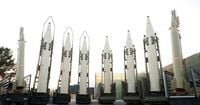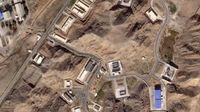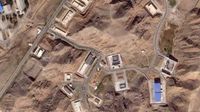Iran is racing to rebuild its missile production infrastructure just months after devastating Israeli strikes, but a crucial piece of the puzzle remains out of reach. Satellite images reviewed in September 2025 by The Associated Press and other outlets reveal that construction crews are hard at work at key missile sites, including Parchin and Shahroud, both of which were heavily targeted during the 12-day war with Israel in June. Yet, despite the flurry of activity, the large planetary mixers required to manufacture solid-fuel missile propellant are still missing, leaving Iran’s missile ambitions in a precarious state.
The urgency behind these efforts is palpable. The June conflict decimated much of Iran’s air defense systems, leaving its missile arsenal as one of the few remaining deterrents against what Tehran fears could be another round of war with Israel. According to The Associated Press, the Islamic Republic sees reconstituting its missile program as absolutely vital, especially with the specter of renewed United Nations sanctions looming later this month. These sanctions would penalize any further development of Iran’s missile program, among other measures, making the current window for reconstruction particularly critical.
“If they’re able to reacquire some key things like planetary mixers, then that infrastructure is still there and ready to get rolling again,” said Sam Lair, a research associate at the James Martin Center for Nonproliferation Studies who has closely studied Iranian missile sites, in comments reported by AP and other news outlets. The mixers, which feature blades revolving around a central point much like orbiting planets, are essential for evenly combining the chemicals that make up solid missile fuel. Without them, Iran’s ability to mass-produce missiles at prewar levels is severely hampered.
Before the June war, Iran’s missile industry was nothing if not prolific. According to Carl Parkin, a summer fellow at the James Martin Center, Iran was on track to produce more than 200 solid-fuel missiles a month. During the conflict itself, Iran fired 574 ballistic missiles at Israel, and in two prior exchanges, it launched another 330. The Jewish Institute for National Security of America, which maintains close ties to the Israeli military, estimated Iran’s total arsenal at about 2,500 missiles before the war—meaning over a third of its stockpile was expended in just a few weeks of fighting.
The Israeli military, for its part, declined to comment on its targeting strategy, but experts believe the June strikes were meticulously planned to cripple Iran’s missile production at its source. The focus, according to Parkin, was on destroying the buildings that housed the planetary mixers, which are widely regarded as the bottleneck in the missile manufacturing process. “If Iran is able to overcome their mixing limitations, they’ll have all the casting capacity that they need to start producing at high volumes again,” Parkin told The Associated Press.
The satellite images taken in September 2025 by Planet Labs PBC and analyzed by AP show unmistakable signs of reconstruction at both the Parchin and Shahroud facilities. At Parchin, mixing buildings appear to be under repair, while similar activity is underway at Shahroud, involving both mixing halls and other key structures. The speed of the rebuilding effort underscores just how high a priority the missile program is for Tehran. In contrast, nuclear sites damaged by Israeli and U.S. strikes have not seen nearly the same level of postwar activity.
Yet, for all Iran’s determination, the missing mixers remain a stubborn obstacle. With international scrutiny intensifying, especially from the United States, Iran’s options are limited. Experts and U.S. officials say Tehran may turn to China to procure the needed equipment and chemicals. China has supplied missile fuel ingredients and other components in the past, and Western officials believe it remains a likely source. The U.S. State Department recently sanctioned Chinese firms for providing ballistic missile propellant ingredients to Iran, reflecting Washington’s ongoing efforts to choke off the supply chain.
China’s stance is nuanced. The Chinese Foreign Ministry told The Associated Press that Beijing is “willing to continue leveraging its influence to contribute to peace and stability in the Middle East.” At the same time, China reiterated its support for Iran’s “national sovereignty, security, and national dignity,” while expressing “deep concern about the continued escalation of tensions in the Middle East.” This diplomatic balancing act leaves open the possibility that Chinese firms could still play a role in Iran’s missile revival, albeit under a cloud of international scrutiny.
Iran’s ties with China extend beyond simple procurement. Earlier this month, Iranian President Masoud Pezeshkian and senior military officials visited Beijing for China’s Victory Day parade. While neither side issued a detailed readout of the discussions, the timing and context of the visit were not lost on observers. Can Kasapoğlu, a senior fellow at the Hudson Institute, noted in a recent analysis that Beijing could supply not just mixers and fuel ingredients, but also guidance systems and microprocessors for Iran’s ballistic missiles. “If Iran uses its relationship with China to bolster its disruptive military capabilities, the 12-day war could be a mere speed bump for the Iranian regime, rather than a decisive defeat,” Kasapoğlu wrote.
Meanwhile, Iran’s Revolutionary Guard has reportedly supplied a planetary mixer to an underground missile facility in Syria, near Masyaf, according to footage released by the Israeli military. The mixer shown in the footage bore a striking resemblance to models sold online by Chinese firms, further illustrating the global nature of the missile components supply chain.
Iranian officials have been vocal about their determination to press ahead. Defense Minister Gen. Aziz Nasirzadeh declared on August 22, 2025, “The 12-day war with Israel has altered some of our priorities. We are now focused on producing military equipment with higher precision and greater operational capabilities.” President Pezeshkian, in his September 24 address to the United Nations General Assembly, condemned the Israeli and U.S. strikes that damaged Iran’s nuclear sites, calling them “a grievous blow upon international trust and the very prospect of peace in the region.” He also reiterated Iran’s longstanding position on nuclear weapons: “I hereby declare once before this assembly that Iran has never and will never seek to build a nuclear bomb.”
Despite these reassurances, the international community remains wary. With the prospect of renewed U.N. sanctions and the ever-present risk of another round of conflict with Israel, Iran’s missile program sits at the center of a high-stakes geopolitical chess match. The coming weeks may determine whether Tehran can overcome its technical hurdles and restore its missile capabilities—or whether the recent war will prove to be a lasting setback.
For now, Iran’s missile factories are buzzing with activity, but until those elusive planetary mixers are in place, the future of the country’s missile arsenal hangs in the balance.


